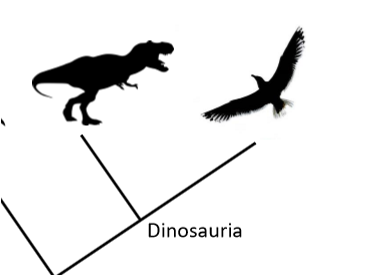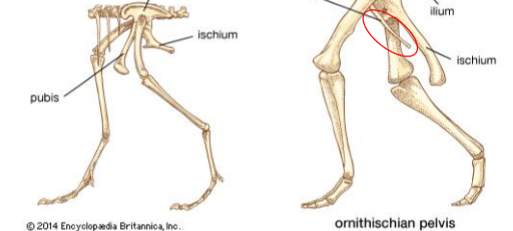8 - types of dinosaurs
1/14
There's no tags or description
Looks like no tags are added yet.
Name | Mastery | Learn | Test | Matching | Spaced |
|---|
No study sessions yet.
15 Terms
dinosauria
Subset of dinosauromorpha
Has some minor modification to some bones
Forearms are more powerful
Opening on each side of the hip where the femur is inserted
Found muscle attachment scars on skulls showing that they had a very powerful bite
Includes all birds and dinosaurs
All birds are dinosaurs but not all dinosaurs are birds

oldest fossils
28,000,000 years ago
Argentina
Had primitive traits
Bipedal
Brazil
So previously thought that South America is where dinosaurs first appeared
Disproven: the rocks age was not common globally
Oldest trackways
242 to 237
Dinosauromorphs
244 to 242
norian time dinosaurs
Dinosaurs on all of pangaea
Diverse, widespread = evolution happened quickly after first appearance of dinosaurs
Non dinosaur dinosauromorphs existed with dinosaurs but went extinct by the end of the late triassic
cause of diversity
Diverse because reproductively isolated + ecological conditions caused them to be so different that they can't interbreed any longer
Natural selection
Some traits were more beneficial than others
Depending on time and place
ex. of eco conditions
Pangea broke up
Mountains eroded
New mountains formed
Rivers changed course
Sea levels changed and sometimes flooded the interior of continents
Temperature changes
Patterns of precipitation changes
defining species
By seeing which animals are mating with each other
Cannot be found in the fossil record so this method is better for living organisms
Exception
Asexual organisms
Some different species can meet with each other to form hybrids
morphospecies
Some reliable characteristics that make them unique compared to all other species
Used to define species in the fossil record
Issue
The difference could be due to different reasons:
Individual variation, sexual dimorphism, ontogenetic change, incomplete fossil record
So usually if two specimens look different then they are probably identified as two different species
gender in fossil record
Genitals do not get preserved
Look for eggs in the body cavity or Medullary bone
The absence of them does not automatically make it a male though
Size difference
Males are not always bigger than females
Ornamentation
age in fossil record
LAGs
Lines of arrested growth
Found in bones and teeth
Form seasonally
Counted to estimate the age
Lack of fusion and skull bones = juvenile
Spongier bones = young
Solid bones = adult
ex. nanotyrannus
Not sure if it's a young T Rex or a dwarf of another species or a juvenile of another species
Small, spongy bone = juvenile
Fused skull = adult but still could be juvenile
Lower jaw has 17 teeth on each side while the T Rex has 11 to 14 on each side
T Rex could lose teeth as they age or there could be natural variation
Differences in the skull and skeleton in terms of proportion and shape and the presence of a dental groove
Due to ontogenetic variation or are they part of another group?
major dinosaur groups
theropods
Mostly carnivorous
ex. T Rex
Sauropodomorphous
Long neck dinosaurs
ex. Brachiosaurus
Ornithischians
All the other dinosaurs
No debate
historical subdivisions of dinosauria
Since 1887 The three groups were divided into two clades
Saurischia
Therapods, sauropodomorphs
Ornithischia
Harry Sealy said that all dinosaurs have 3 bones that make up the pelvic girdle
Ilium
Ischium
Pubis
pubis is oriented into two ways
Down (Towards the head) and forward = saurischians
Lizard hipped
But birds are actually saurischian dinosaurs evolved from theropods
Part of the pubis points backward = ornitischians
Bird hipped
Lies along the lower rim of the ischium
This lineage is extinct

ornithischia
They all have many common characteristics
So more well defined
saurischia
Only have a few common characteristics
So probably were prey
Less well defined
Not totally carnivorous but probably primitively
Long vertebrae in the neck
Large hands
No fifth finger
thumb can crossover the palm
feathers
Mostly found in therapods
2009 - tianyulong
Ornithischian dinosaur
Simple feathers on beak, back, tail
So then feathers had to have evolved twice or as a primitive feature of all dinosaurs
2019
Pterosaurs were found to have had primitive feather like structures
So feathers may have been a diagnostic characteristic of all ornithodirans
reorg. of groups in dinosauria
2017 Baron
Proposed an new cladogram that group therapods and ornithischians into a new group called ornithoscelida Based on the principle of parsimony
Suggests that hips are not a diagnostic character
2 main branches are now
Sauropoda
ornithoscelida
Theropoda
ornithischia
Evidence
Some members of ornithischians, theropoda have feathers or feather like structures but sauropodomorphs and Herrerasaurids seem to not
Primitive ornithischians looked similar to therapods
Doesn't make sense for birds to be lizard hipped dinosaurs
Issues
sauropodomorphs and therapods have pneumatic bones AKA bones with air sacs but ornithischians do not
But pterosaurs do so it could just be a primitive trait of all ornithodira
Requires carnivory to evolve twice
Once in therapods and then again in Herrarasaurids
So still not sure